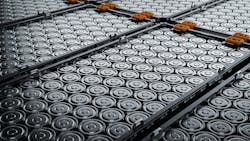Blog: Hey Graduate, The Future Really Is in Batteries (But China's Got the Edge)
I just want to say one word to you … just one word: batteries.
Professionals in the plastics sector are all too familiar with this worn-out homage to “The Graduate.”
The point here, for the chemical industry, is that there truly is a future in battery materials. Demand for lithium-ion batteries, by gigawatt hour, is forecast to grow at a compound annual growth rate of 15.5% from 2024-2034, according market intelligence firm IDTechEx.
On Oct. 28, the U.S. Department of Energy said it closed a $2.26 billion loan to Lithium Americas Corp’s subsidiary, Lithium Nevada Corp., to help finance the construction of facilities for processing lithium at Thacker Pass in Humboldt County, Nevada.
As we noted in an Oct. 29 Chemical Processing article, the market for more efficient mining methods, like direct lithium extraction, or DLE, are gaining traction.
Chemical Processing Editor-in-Chief Traci Purdum was quite prescient when she saw an opportunity to cover a growing industry by enlisting Barry Perlmutter to begin his “Barry on Batteries” column in 2023.
In early October, I attended the Reuters Industrial Decarbonization North America event in Pittsburgh, where several key players in the battery sector discussed advancements and challenges related to battery mining and processing.
Among those discussing the battery industry was Killian Charles, president and CEO of Brunswick Exploration, a Montreal-based lithium mining company.
The following are some key points I noted from Charles’ discussion:
China Dominates the Supply Chain: The North American lithium supply chain is “nearly nonexistent.” Charles cited the need to build more mines in the Western democratic regions, including North America, Europe and Australia, to develop a sustainable and stable supply chain.
In his words: “China dominates lithium refining – obviously they dominate lithium battery production to the tune of 80-85%. They historically did not dominate raw production; they will dominate raw production probably by the end of 2026, where they’ll probably account for 60% of raw lithium production. . . . The simple answer is, we need to build assets here. And it is very, very slow and long and complicated to build mines in the West. Frankly, we just don't do that, and it's a problem because that's how we're going to build that supply chain.”
Charles said building mines in these regions is more sustainable because, unlike China, regulatory standards are in place to ensure environmentally sound production. Those regulations also mean the lithium extracted from the West will trade at a premium, placing China – as a major buyer of lithium – at a competitive disadvantage.
Evolution of Battery Technology: “Lithium is a technology that is rapidly changing. When we think about EVs or anything else, we haven't even seen the final form of what it can do, and we haven't seen the final form of what renewable energy can do in terms of bringing cost savings.” The rising demand for renewable energy will increase the need for battery storage solutions, including lithium, Charles said. In addition, he noted that while Western nations may not lead on the lithium production side, they do have an edge in research and development. That know-how should lead to more advanced technologies in the future. As he said, “If you go back 10 years ago, we were struggling to get 150, 200 miles off an EV, and now that's pretty easily achievable for even the cheapest EV cars out there. And 10 years from now, it's going to change again.”
The Role of Technology/Artificial Intelligence: While exploration and mining are old school, Charles said AI does show potential for certain applications, including the identification of new lithium sources. “We’ve been using a little bit of AI, dipping our toes into it,” he said. Charles mentioned that a group of Silicon Valley investors, including Microsoft founder Bill Gates and Amazon’s Jeff Bezos, have backed a company called KoBold Metals, which uses AI to search for metals such as copper, lithium and cobalt. However, at the end of the day, the industry must still send someone out to a site, often by helicopter, to investigate a potential mineral resource, he said.
Lithium Processing Safety on Notice
As a side note, while I was writing this blog, I noticed our battery expert, Barry Perlmutter, had commented on LinkedIn about a recent explosion at a battery recycling plant in Fredericktown, Missouri, on Oct. 30. The company that owns the plant, Critical Mineral Recovery, says it recycles lithium-ion-battery-related materials at the 225,000-square-foot plant, according to a Chicago ABC affiliate.
Perlmutter responded to a post by James Roberts, who lists himself as a senior analyst of OT cyber assessments for engineering and consulting firm Michael Baker International. Roberts noted that the incident “underscores critical challenges in fire safety for battery processing facilities, even those with claimed advanced detection and suppression systems.”
He added that a news report stated the company claimed on its website that it has “likely the most sophisticated automated and remote supervised and controlled fire suppression systems in the world." This includes 24/7 remote monitoring and high-intensity industrial infrared cameras.
In June, a fire at a South Korean lithium plant killed 22 workers. Perlmutter followed with a column stating the importance of building a safety culture into the lithium-ion battery value chain.
If you haven’t read it already, check out “Barry on Batteries: Chemical Industry Safety Insights for Lithium-Ion Battery Processing” for his perspective on safety within battery processing facilities.
About the Author
Jonathan Katz
Executive Editor
Jonathan Katz, executive editor, brings nearly two decades of experience as a B2B journalist to Chemical Processing magazine. He has expertise on a wide range of industrial topics. Jon previously served as the managing editor for IndustryWeek magazine and, most recently, as a freelance writer specializing in content marketing for the manufacturing sector.
His knowledge areas include industrial safety, environmental compliance/sustainability, lean manufacturing/continuous improvement, Industry 4.0/automation and many other topics of interest to the Chemical Processing audience.
When he’s not working, Jon enjoys fishing, hiking and music, including a small but growing vinyl collection.
Jon resides in the Cleveland, Ohio, area.

